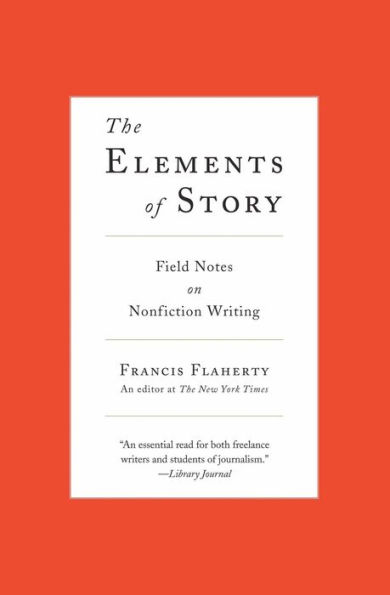

Paperback
-
PICK UP IN STORECheck Availability at Nearby Stores
Available within 2 business hours
Related collections and offers
Overview
In the spirit of Strunk and White’s classic The Elements of Style, comes The Elements of Story, by Francis Flaherty, longtime story editor at The New York Times. A brilliant blend of memoir and how-to, The Elements of Story offers more than 50 principles that emphasize storytelling aspects rather than simply the mechanics of writing—a relentlessly entertaining, totally accessible writing guide for the novice and the professional alike.

Product Details
| ISBN-13: | 9780061689154 |
|---|---|
| Publisher: | HarperCollins |
| Publication date: | 09/07/2010 |
| Pages: | 293 |
| Sales rank: | 632,894 |
| Product dimensions: | 5.20(w) x 7.90(h) x 0.80(d) |
About the Author

Read an Excerpt
The Elements of Story
Field Notes on Nonfiction Writing
Chapter One
Shivers on Wall Street
Every story has a human element.
Whatever your subject, give it a human face if you can. Imagine a story about people who had enough money to invest in the American stock market in 1996, but, for various reasons, did not. Maybe they believed real estate was a better deal. Maybe they wanted to bet on bonds. Or maybe they thought overseas stock markets were the place to be.
But they were wrong. Nineteen ninety-six was a banner year on Wall Street, with the Dow Jones industrial average rising 26 percent.
A Times article about these unfortunates appeared in the business pages, and necessarily explored many technical subjects that readers expect to see in that part of the paper—the reasons for the large gain, comparisons to past years, the investors' mistaken theories, and the prospect that their ideas, dry holes in 1996, might strike oil in 1997.
Sounds dull. Sure, you say, this article may be useful to investors, but it hardly seems gripping.
Can it be both?
The answer is yes. There is an emotional center to this story. People who miss out on a good thing are prey to regret, anger and jealousy. Such feelings, in fact, were the original inspiration for the article.
For that reason, I wrote a lead that went like this:
They are on the outside looking in, noses pressed against the glass, stamping their feet in the chill, watching the festivities within.
Yep, that's right. These are investors who did not attend the Wall Street Revels of 1996. Stocks may have soared and portfolios mayhave swelled, but these people made less money than the overall market would suggest, or maybe none at all.
This lead displays for the reader the emotions of those left out in the cold. You can elect to write about made-up people, as this lead does, or about real ones, but do not ignore the human side. If you do, your tale will be ho-hum, like this hypothetical lead to the same story:
Nineteen ninety-six was a banner year for the stock market, with the Dow Jones industrial average rising 26 percent and the shares of many individual enterprises soaring far higher. But some investors, for various reasons, chose not to participate in the market that year. . . .
Boring! Even in significantly technical articles like this investing story, maybe especially in such stories, always fleck at the human feelings in play. As the late Jack Cappon of the Associated Press put it, "The tight housing market is also an old lady evicted with her four cats."
The Elements of StoryField Notes on Nonfiction Writing. Copyright (c) by Francis Flaherty . Reprinted by permission of HarperCollins Publishers, Inc. All rights reserved. Available now wherever books are sold.
What People are Saying About This
“Frank Flaherty’s The Elements of Story is a model of good sense, a clear, well-lighted path through the jungle of nonfiction narrative. It represents so much accrued wisdom that even veteran writers will want to keep it on hand, and it’s fun to read, too.”
“Frank Flaherty has found the perfect voice to guide writers in creating muscular yet nimble prose. He’s encouraging and friendly (exuberant, even!), assured and wry. A delight to read, The Elements of Story makes me itch to write.”
“Ailing writers, not to worry. There is a Story Doctor in the house. His name is Frank Flaherty, and his powerful medicine is on every page of The Elements of Story. It belongs on your shelf right there next to that other Elements book.”
“A virtual Merck Manual for story doctors, filled with insightful diagnoses and effective prescriptions.”
“Francis Flaherty has turned his love of writing into a book that will help journalists produce nonfiction that provides life enriching articles that can hold their own against the most imaginative fiction.”
“Flaherty’s book will be the classic yardstick for how to grab readers and not let go until they see and hear and think exactly what the author has seen, heard, and thought.”
“Frank Flaherty’s writing guide is fluid, fun and filled with brilliant advice for anybody who wants to improve their work, break into this country’s top newspapers or get a glimpse into an editor’s mind.”



